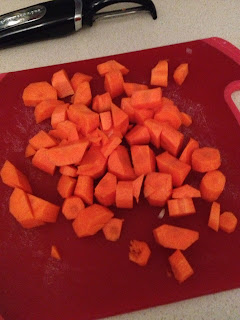Homemade chicken stock is easy to make and provides many benefits to the gut and intestines to aid in digestion. It is also said to provide many other benefits including reducing allergies and healing nerves. And you can't beat the difference in taste from the store varieties. You will never need to buy cartons of chicken stock again!
Homemade Chicken Stock
Ingredients:
Chicken bones from 1 free-range chicken (optional: add in some chicken feet and/or chicken gizzards)
1 large onion, roughly chopped
2 large carrots, roughly chopped
3 large celery stalks, roughly chopped
2 Tbsp apple cider vinegar
4 quarts (or 16 cups) of filtered or spring water
1 bunch of fresh parsley
Directions:
1. After I roast a whole chicken and remove the meat, I use the bones to make chicken stock. Roughly chop up the vegetables and add them to a large slow cooker.
2. Add in the chicken bones, apple cider vinegar, and as much of the water as will fit in the slow cooker.
3. Heat the stock on low heat in the slow cooker for at least 12 hours, or as much as 24 hours. I like to cook it for the full 24 hours to get as much taste and deep chicken stock color as I can.
4. About 30 minutes before the stock is done, add in the bunch of parsley.
5. When the stock is finished, strain it well. Pour the reserved stock into mason jars and put the lids on tightly. Keep the stock in the refrigerator. If you want, you can also put the stock in jars that can be frozen and freeze them. This recipe usually makes about 3 quarts. The chicken bones can be re-used over and over to make more chicken stock until the bones start to disintegrate.
After having some recent stomach issues, I finally started making some fermented foods. Fermented foods provide gut-friendly bacteria and take the place of any kind of probiotic. If you aren't eating any fermented foods, I would recommend starting or making sure you are keeping your gut safe with probiotics, healthy yogurts, etc. Fermented foods sounds a little scary and complicated, but it is actually very very easy! Below are a few variations for making some pickled cucumbers (aka pickles). Using this type of preservation method, your fermented cucumbers will keep about 1-2 months. They are great as a side dish for most meals or for a quick snack. I will show below two different variations (one adapted from The Elliott Homestead and the other adapted from the Nourishing Traditions cookbook.
Tip: There are two methods I have heard of for keeping your pickled cucumbers nice and crispy. The first is to make sure you use them within 24 hours of picking them. The other is to put a grape leaf or two in your jar, which is supposed to help keep them crispy as well.
Pickled Cucumbers
(makes about 1 qt)
Ingredients:
4-5 pickling cucumbers or small cucumbers
Filtered or spring water
1-2 Tbsp fresh dill (depends on your taste, I usually use about 1 Tbsp)
1-2 Tbsp sea salt (use 1 Tbsp if using whey, 2 Tbsp if not using whey)
4 Tbsp whey (optional)
Optional: either use 1 Tbsp mustard seeds or use 1 clove of garlic peeled and smashed, 5 peppercorns, and a pinch of red pepper flakes (You could also play around with some other seasonings to your desired taste)
Optional: use a grape leaf or two in the jars to keep them crispy, if available
Directions:
1. Wash out your jar(s) - this recipe will make about 1 quart of pickles. Also wash your cucumbers and slice to your liking. I choose to cut them in half or quarters and then make small slices.
2. Put sliced cucumbers in the jar, pushing them down so they are tightly packed in there.
3. In a small bowl, stir together about 1 c. water, salt, dill, and optional seasonings (either the mustard seeds or 1 clove of garlic peeled and smashed with a pinch of red pepper flakes and 5 peppercorns). If using whey or grape leaves, mix this in too. Pour the mixture into the jar(s). Add a little more water, if needed, so everything is covered with water but does not exceed 1 inch from the top of the jar.
4. Cover the jar(s) tightly and place on the counter to sit at room temperature for about 2-3 days. After the 2-3 days are up, unscrew the caps to let a little bit of air out of the jar, and then put the lids back on tightly. Place in the refrigerator until ready to use; should keep about 1-2 months.
5. Enjoy!! :)












